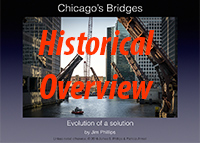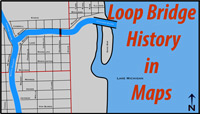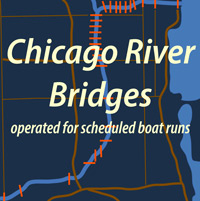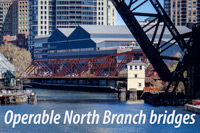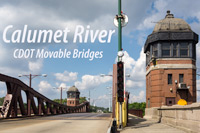The following story is provided by Lex Vink of Hoeilaart, Belgium. An 1883 accident at the Polk St. bridge involving his great-great uncle's family led him on an odyssey to Chicago in September 2011.
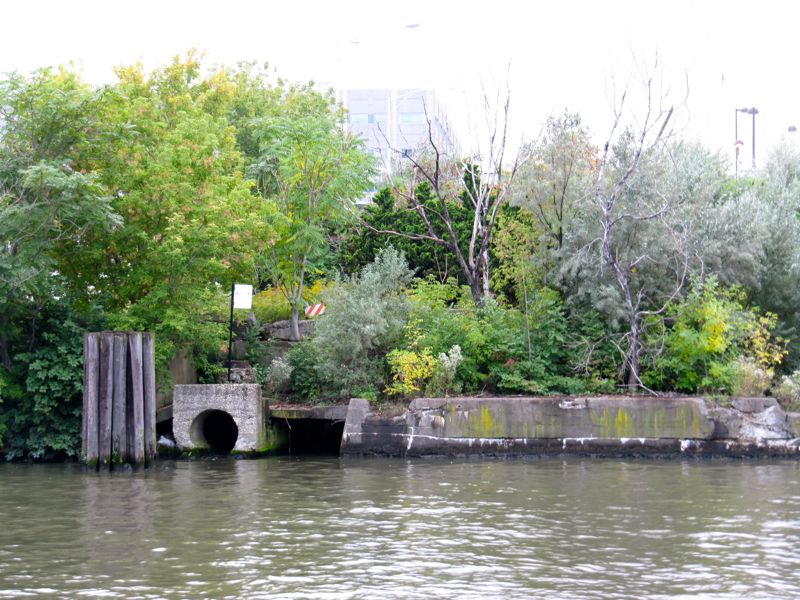
The remains of the last bridge built at W. Polk St. (photo © 2011 Lex Vink )
Half a mile south of the Chicago Loop, where boat tours make their turn on the river, one can still see remnants of the abutment of what used to be the Polk street bridge. This defunct bridge conveys an interesting story of how safety at the bridges was considered in the nineteenth century.
On the second of August 1883 around 7 PM a horse drawn carriage with four persons inside was approaching the open swing bridge at Polk street. The bridge approach was on a viaduct above the tracks of the Chicago & Alton railroad and train engineers had a habit of blowing the whistles of their engines here. A train whistle frightened the team of horses causing them run uncontrollably pulling the carriage into the greasy and dirty river.
The three children inside the carriage drowned as the carriage sank. Their father (James VanBezey) was able to save himself by leaping from the vehicle. The driver was picked up by a boat on the river, his ankles were sprained. Hundreds of people watched the spectacle which followed. The carriage was dragged to the surface of the river. The remains of a fourteen year old girl were found inside. Dragging continued, but the other two youngsters, a girl of twelve and a boy ten years old, were not found until the next morning.
The family belonged to the Dutch community in Chicago, who were living in what is now Little Italy. Two thousand people attended the funeral service in and around the Dutch Reformed Church, situated at the time at the corner of Polk and May streets. Three white hearses carried three white coffins from the church to Graceland cemetery.

Graves of the victims of the 1883 accident at the Polk St. bridge (photo ©2011 Lex Vink)
The terrible accident was the general topic of conversation in the city for a number of days. Newspapers reported extensively. It was not the first time that someone was drowned at the Chicago bridges, but the sight of three children in white coffins was too impressive to ignore.
Some of the Aldermen took up the matter in the City Council: “That the commissioner of public works is hereby directed to advertise for and invite parties having safeguards, gates, or other appliances for protection to the approaches of the bridges along the Chicago river, to present the same to him with the cost of erecting such safeguards, and make report to this council at his earliest opportunity. Also that the commissioner notify all railroad companies, and owners of steamers, propellers, tugboats, steam barges, and canalboats, that when passing under viaducts, within the limits of the city, and going through the approaches or under the bridges along the Chicago river, to prohibit whistling, ringing of bells, and to avoid as much as possible the escape of steam”.
Another motion was passed “to direct the law department to prosecute the Chicago & Alton railroad for violation of the city ordinances in allowing an engineer to blow off steam under the viaduct in the case of the recent accident”. On a motion of yet another Alderman “an order was passed providing that every bridgetender shall be supplied with ring-bugs and ropes, to safe life when necessary”.
The Aldermen were not unanimous in their outrage, however. Some commented that these motions simply invited all crank inventors to go to work. They scolded their colleagues for bidding in that manner for public applause.
Of all the newspapers reporting on the accident, the 'Chicago Daily Tribune' had the sharpest criticism: “Mayor Harrison should take an active and personal interest in this matter. He is in as much danger as other citizens. He may be the very next victim. Or one of his saloon-keeping Aldermen may drive into the river and lose his valuable life and his lucrative place at the same time. Death by water would be especially horrible to one of those gentlemen, and the Mayor would be heartbroken at such a loss. This view of the case ought to bring the danger home to the city authorities. It ought to induce them to provide a remedy immediately. We think there is no other city in the world where such a danger as open bridges at night, without guardians or gates, or even proper lights, would be tolerated”.
According to the 'Chicago Times', Mayor Harrison, the mayor who ten years later was a driving force behind the World's Columbian Exposition, commented: “This was a peculiarly sad and distressing accident, but in the excitement of the moment the people do not control their feelings as they ought. Why, just think of it. There are probably fifty millions of persons crossing the bridges in the city during the year, and in that time how very few accidents do we have. The number is so small in comparison as to become infinitesimal. People are in more danger of being run over by horses in the streets, of falling out of windows when looking out, of meeting with fatal accidents by falling down stairs, but the city is not called upon to protect its citizens against such dangers. There is always a craze after such an accident, just as there was after the Newhall house fire. Cranks for the most part, and a few sensible men began the invention of fire escapes, and my office was flooded with plans and specifications of every conceivable kind. To-day I have had about a dozen calls from inventors of bridge gates. But we can do nothing about the matter because the evil to be remedied is comparatively so small”.
The city engineer, Commissioner Cregier, the patented inventor of fire hydrants as a combination of drinking fountain, fire hydrant, and watering basin for animals, sided with his boss by commenting “Automatic gates have been tried, but have been proven to be worthless, and the only way to do any good would be to station a man at each end of the bridge. He could swing double gates when the draw is open, and that would make the situation comparatively safe. But that would take sixty-six men for all the bridges in the city at an annual salary of about $66.000. The number of accidents at bridges is so small in proportion to fatal occurrences in a thousand other different ways, every day, that such an expensive method of precaution would not be warranted.”
Answering a question on damages to be recovered the city Attorney added that “the responsibility must be divided between the driver, for placing his team in a position to be frightened, and the railroad company, for improperly whistling where they had no right to. The city is in no way liable. The driver knew that the draw was open, and he was also aware that underneath the railway viaduct trains were continually passing. If he had remained a safe distance from the bridge, the accident would never have happened”.
The Jury, however, concluded to be “at a loss to account for the total indifference of the city authorities in not providing safeguards at the approaches to the city river bridges” and censored the city “We are constrained on this occasion to denounce this neglect on the part of our city as nothing short of criminal negligence”. The 'Daily Inter-Ocean' added that had there been any kind of a boat or scow at Polk street bridge, the catastrophe might not have been so fatal as it was. The newspaper interviewed the bridgetender who, in self-defense, said he had been asking the Superintendent of Bridges for a boat for more than a month, but all to no avail. Even the rope in the bridge grappling hook was so rotten that it had to be replaced by a good one before the hook could be used.
After a week, there was no more news in the newspapers about the accident. Real safety measures took years before they were implemented.
Today, when you happen to be waiting for an open bridge during lift season, you may see the yellow-dressed group of people overseeing the opening of the bridges and think of what happened a hundred and thirty years ago. After all, safety has become an important issue if not the most important issue in today's bridge technology.
Lex Vink Hoeilaart (Belgium), November 2011
alexandervink@scarlet.be

More on the Polk Street bridge at Forgotten Chicago

